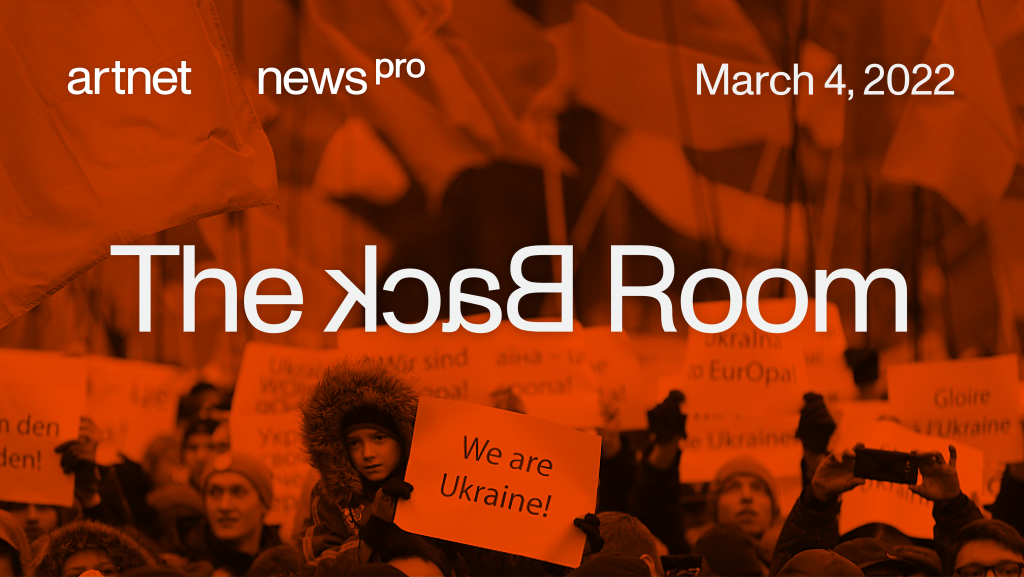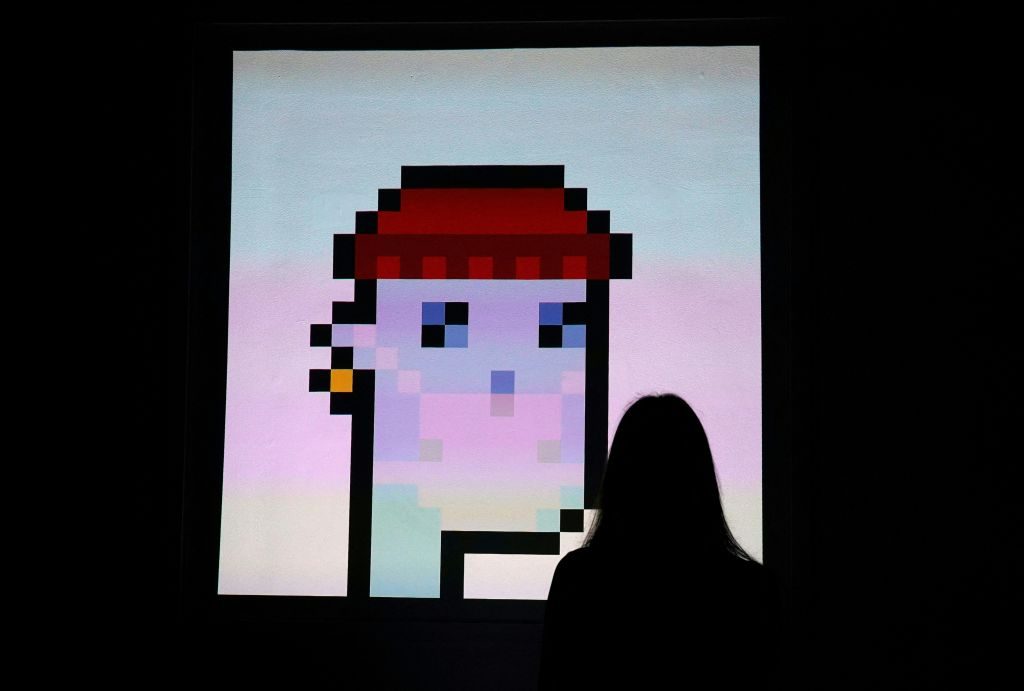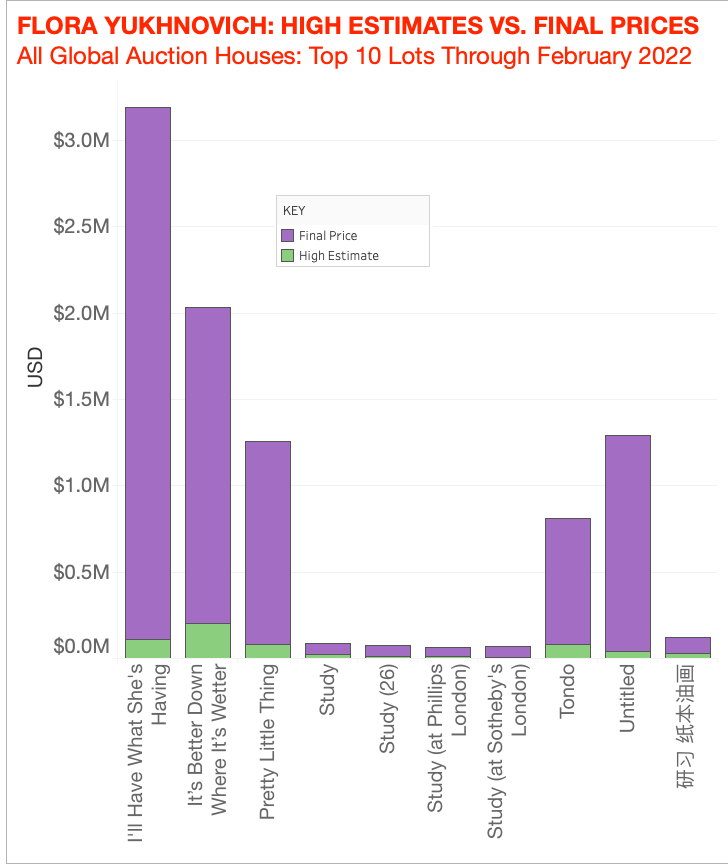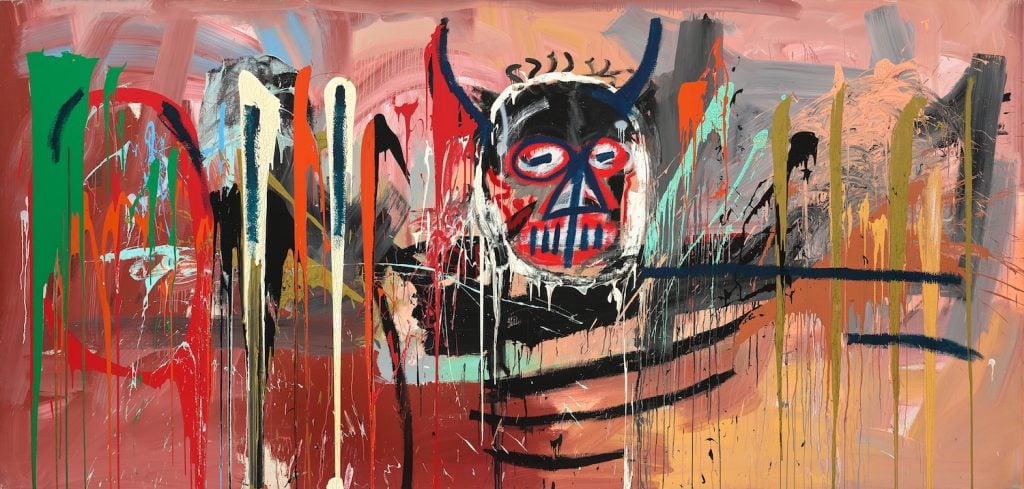The Back Room
The Back Room: Red Alert
This week: the war's blowback on the art economy, a CryptoPunk collusion, high-flying auction action, and much more.

This week: the war's blowback on the art economy, a CryptoPunk collusion, high-flying auction action, and much more.

Tim Schneider

Every Friday, Artnet News Pro members get exclusive access to the Back Room, our lively recap funneling only the week’s must-know intel into a nimble read you’ll actually enjoy.
This week in the Back Room: the war’s blowback on the art economy, a CryptoPunk collusion, high-flying auction action, and much more—all in an 8-minute read (2,231 words).
__________________________________________________________________________

Phillips London’s 20th century and contemporary art evening sale. Image © Thomas De Cruz Media Haydon Perrior.
As Russia’s increasingly brutal invasion of Ukraine enters its second week, no concern outweighs the ghastly, worsening human toll. Yet the war’s lesser consequences are shaking the halls of wealth, finance, and commerce worldwide, which means the art business is feeling the effects, too.
Nowhere in the industry were anxieties about the conflict’s legal and financial impacts greater than at London auction week, where the Big Three houses hoped to do hundreds of millions of dollars in business. But the sales were exposed to new risks as international economic sanctions ratcheted up against institutions and elites linked to Vladimir Putin…
No wonder the largest questions at London auction week surrounded Phillips.
Owned by Russian nationals Leonid Fridlyand and Leonid Strunin (via their luxury conglomerate, Mercury Group), the house worked all week to reassure consignors, bidders, and intermediaries that their artwork and/or sales proceeds were at no risk.
Phillips CEO Stephen Brooks even made calls himself to relay his personal version of what a house spokesperson told my colleagues: “The owners of Phillips are not the subject of sanctions and have no connections to any individuals or institutions that may be included directly or indirectly in any sanctions list.”
Still, by Thursday morning, some art-world figures (including collector Andy Hall and former Bonhams CEO Matthew Girling) were calling for a Phillips boycott. The house then announced it would donate 100 percent of its net proceeds from Thursday’s 20th century and contemporary evening auction to the Ukrainian Red Cross Society.
The shrewd move likely helped Phillips secure a within-estimate £30 million ($40 million) during the sale. This means its donation will total £5.8 million ($7.7 million). Christie’s and Sotheby’s also beat back uncertainty, bringing in more than $630 million in combined sales (see Paint Drippings for details).
Yet the success of London auction week hardly means the art business can breathe easy. As long as the war in Russia and the corresponding sanctions persist, the following issues will demand extra attention, care, and costs…
Various laws require businesses to identify the ultimate beneficial owner of limited liability companies, trusts, and private foundations, partly to steer clear of transacting with any specially designated nationals or sanctioned individuals—especially through a third-party intermediary.
Although U.S. art dealers have so far avoided even more stringent industry-specific regulations of this type, their British and E.U. counterparts are not as fortunate. International auction houses too have to be rigorous in this regard at all times, but even more so now.
As the economic clamps tighten, wealthy Russians will only grow more desperate to convert hard assets like artworks into cash at distressed prices. This means the temptations for art sellers and “runners” (the term of art for shadier go-betweens) to lapse or look the other way will only intensify.
The good news? Ukraine’s government has been accepting millions of dollars in donations via cryptocurrency, including more than $3 million raised via NFTs. Ukrainian aid organizations are also benefiting, most notably via UkraineDAO, which just sold a “one of one” NFT of the nation’s flag for 2,100 ETH ($6 million).
The less good news? Up to $60 million worth of rubles were being converted to crypto daily as of Monday, per research firm Chainalysis. Some of the world’s largest crypto exchanges (including Binance, Coinbase, and FTX) are so far refusing to restrict any, or nearly any, Russian accounts.
In theory, the public nature of blockchain records provides a way to verify that a buyer hoping to pay for art or NFTs in crypto is legit. In practice, it can create more cloaking for capital flight by tech-savvy people with something to hide. Seller beware.
Put simply, even if you’re sure a deal is free of legal and ethical jeopardy today, do you want to be seen doing business with prominent Russians or Russian-owned entities right now? Could it have negative effects elsewhere down the line?
Carriers often used Russian airspace for shortcuts to and from Asian hubs, according to Fritz Dietl, founder of art-logistics company Dietl International. The need to reroute around the war will increase flight times and fuel consumption, with the higher costs being passed on to clients.
__________________________________________________________________________
Major Russian art buyers and patrons are already backing away from the culture sector, perhaps partly because the culture sector is backing away from them, too.
Newly E.U.-sanctioned banker Petr Aven just bailed from the board of London’s Royal Academy, and the institution returned his recent donation to its Francis Bacon show. Oligarch Vladimir Potanin, who has so far avoided sanctions, resigned from the board of the Guggenheim.
Roman Abramovich’s sudden attempts to sell Premier League juggernaut Chelsea F.C., along with several London properties, could be previews of a coming art liquidation before he too is slapped with international penalties. (Israel’s Holocaust memorial and museum is advocating for Abramovich to remain sanction-free.)
For every sector of the art business, the situation is going to get more complicated before it gets simpler. But if any of us ever feels the urge to complain about that, we should ask ourselves whether we’d rather trade our problems for those of Ukraine’s residents.
____________________________________________________________________________

A Larva Labs CryptoPunk. during a media preview on June 4, 2021, at Sotheby’s.(Photo by TIMOTHY A. CLARY/AFP via Getty Images)
In the latest Wet Paint: Remember 0x650d, the consignor who bragged on Twitter about “rugging” Sotheby’s with an 11th hour withdrawal of 104 Cryptopunks expected to sell for $20 million to $30 million? Well, crypto-fluent sources (including our own Kenny Schachter) say the cancellation was a joint decision by Sotheby’s and 0x650d, spurred by good ol’ fashioned lack of demand.
Meanwhile, two sizzling artists have defected from tastemaking gallery JTT ahead of its relocation to Tribeca: enfant terrible Jamian Juliano-Villani and master of skin-crawling sculptures Dan Herschlein. (Juliano-Villani is still riding with Massimo de Carlo, and Herschlein with Matthew Brown.)
Here’s what else made a mark around the industry since last Friday morning…
Art Fairs
ARCO Madrid attracted more than 70,000 visitors and reported big-ticket sales, which dealer Belén Herrera Ottino of Marlborough Gallery‘s Madrid branch chalked up to everyone having been “oppressed for too long.” (Artnet News Pro)
Auction Houses
Galleries
Institutions
NFTs and More
____________________________________________________________________________

© 2022 Artnet Worldwide Corporation.
At Sotheby’s London on Wednesday, Flora Yukhnovich’s Warm, Wet ‘N’ Wild (2020) reset the artist’s auction record to £2.7 million ($3.6 million), more than 11X the painting’s high estimate. It’s only the latest case of drastic outperformance by one of the market’s young comets.
Click through below to read Yukhnovich assess her head-spinning rise in her own words.
____________________________________________________________________________
“Everything we say now can be used against us in the future… No one could imagine this. Now anything is possible. We understand that the next hit will be against the enemies inside Russia. It’s us.”
—a Russia-based museum staffer and petition signer, speaking on condition of anonymity about the dangers faced by in-country culture workers willing to speak out against the invasion of Ukraine. (Artnet News)
____________________________________________________________________________

Jean-Michel Basquiat, Untitled (1982). Image courtesy Phillips.
____________________________________________________________________________
Estimate: $70 million
Selling at: Phillips New York
Sale Date: May 18
The circle of auction life continues unbroken. Just before gavels fell in London this week, the major houses unveiled a few prime lots for their May sales in New York. Christie’s will be the first ever to auction Vincent van Gogh’s Fields Near the Alpilles (1889), once owned by Yves Saint Laurent and Pierre Bergé, at an estimate of $45 million. Phillips will aim higher with this robustly pedigreed (and apparently Russia-agnostic) Basquiat.
Untitled (1982) currently boasts the third-highest price ever paid for a JMB canvas at auction: $57.3 million, shelled out by billionaire entrepreneur Yusaku Maezawa at Christie’s in May 2016. Six years later, Maezawa is sending the work back to the block, and Phillips hopes it can coax at least a $12.7 million markup out of the return trip. A third-party guarantee is already in place.
Still, Phillips is pulling every lever in reach to try to send the final price higher. Untitled is already in London to kick off a multi-city tour, with intermediate stops scheduled in Los Angeles and Taipei before it lands at Phillips’s Park Avenue flagship. Once the sale goes live, bids will be accepted in Bitcoin, Ether, and all major fiat currencies.
One thing these efforts probably won’t change, though, is which Basquiat work wears the all-time auction crown. When the dust settles, the king is still likely to be the other major untitled painting from 1982 currently owned by Maezawa. He paid Sotheby’s $110.5 million for the latter work (which features a giant skull against a field of blue) a year after buying this one for about half the price from its chief rival. New decade, SAMO story, I guess…
____________________________________________________________________________
With contributions by Naomi Rea.